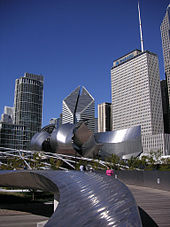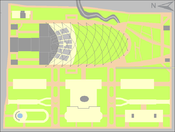
Grant Park is a large urban park in the Loop community area of Chicago, Illinois. Located within the city's central business district, the 319-acre (1.29 km2) park's features include Millennium Park, Buckingham Fountain, the Art Institute of Chicago, and the Museum Campus.

Wrigley Square is a public square located in the northwest section of Millennium Park in the Historic Michigan Boulevard District of the Loop area of Chicago in Cook County, Illinois, United States. The square is located at the southeast corner of the intersection of East Randolph Street and North Michigan Avenue. It contains the Millennium Monument, a nearly full-sized replica of the semicircle of paired Roman Doric-style columns that originally sat in this area of Grant Park, near Michigan Avenue and Randolph Street, between 1917 and 1953. The square also contains a large lawn and a public fountain.
The year 2004 in architecture involved some significant architectural events and new buildings.
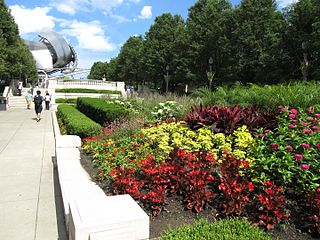
Millennium Park is a public park located in the Loop community area of Chicago, operated by the Chicago Department of Cultural Affairs. The park, opened in 2004 and intended to celebrate the third millennium, is a prominent civic center near the city's Lake Michigan shoreline that covers a 24.5-acre (9.9 ha) section of northwestern Grant Park. Featuring a variety of public art, outdoor spaces and venues, the park is bounded by Michigan Avenue, Randolph Street, Columbus Drive and East Monroe Drive. In 2017, Millennium Park was the top tourist destination in Chicago and in the Midwest, and placed among the top ten in the United States with 25 million annual visitors.

The Chicago Pedway is a network of tunnels, ground-level concourses and bridges in Chicago, Illinois connecting skyscrapers, retail stores, hotels, and train stations throughout the central business district.
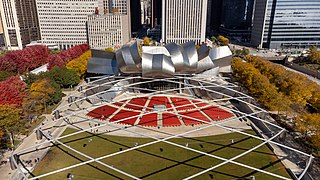
Jay Pritzker Pavilion, also known as Pritzker Pavilion or Pritzker Music Pavilion, is a bandshell in Millennium Park in the Loop community area of Chicago in Cook County, Illinois, United States. It is located on the south side of Randolph Street and east of the Chicago Landmark Historic Michigan Boulevard District. The pavilion was named after Jay Pritzker, whose family is known for owning Hyatt Hotels. The building was designed by architect Frank Gehry, who accepted the design commission in April 1999; the pavilion was constructed between June 1999 and July 2004, opening officially on July 16, 2004.
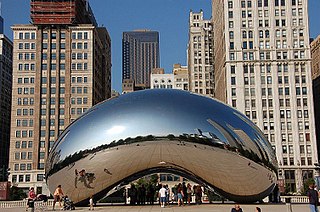
Cloud Gate is a public sculpture by Indian-born British artist Anish Kapoor, that is the centerpiece of AT&T Plaza at Millennium Park in the Loop community area of Chicago, Illinois. The sculpture and AT&T Plaza are located on top of Park Grill, between the Chase Promenade and McCormick Tribune Plaza & Ice Rink. Constructed between 2004 and 2006, the sculpture is nicknamed "The Bean" because of its shape, a name Kapoor later grew fond of. Kapoor himself even uses this title when referring to his work. Made up of 168 stainless steel plates welded together, its highly polished exterior has no visible seams. It measures 33 by 66 by 42 feet, and weighs 110 short tons.
Richard Herman Driehaus was an American businessman, investor, and philanthropist. He was the founder, chief investment officer, and chairman of the hedge fund, Driehaus Capital Management LLC, based in Chicago.

The Joan W. and Irving B. Harris Theater for Music and Dance is a 1,499-seat theater for the performing arts located along the northern edge of Millennium Park on Randolph Street in the Loop community area of Chicago in Cook County, Illinois, US. The theater, which is largely underground due to Grant Park-related height restrictions, was named for its primary benefactors, Joan and Irving Harris. It serves as the park's indoor performing venue, a complement to Jay Pritzker Pavilion, which hosts the park's outdoor performances.

Crown Fountain is an interactive work of public art and video sculpture featured in Chicago's Millennium Park, which is located in the Loop community area. Designed by Spanish artist Jaume Plensa and executed by Krueck and Sexton Architects, it opened in July 2004. The fountain is composed of a black granite reflecting pool placed between a pair of glass brick towers. The towers are 50 feet (15.2 m) tall, and they use light-emitting diodes (LEDs) to display digital videos on their inward faces. Construction and design of the Crown Fountain cost $17 million. The water operates from May to October, intermittently cascading down the two towers and spouting through a nozzle on each tower's front face.
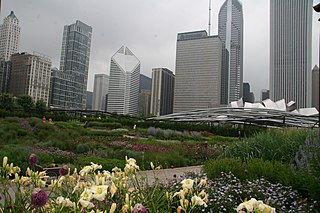
Lurie Garden is a 2.5-acre (10,000 m2) garden located at the southern end of Millennium Park in the Loop area of Chicago in Cook County, Illinois, United States. Designed by GGN, Piet Oudolf, and Robert Israel, it opened on July 16, 2004. The garden is a combination of perennials, bulbs, grasses, shrubs and trees. It is the featured nature component of the world's largest green roof. The garden cost $13.2 million and has a $10 million endowment for maintenance and upkeep. It was named after Ann Lurie, who donated the $10 million endowment. For visitors, the garden features guided walks, lectures, interactive demonstrations, family festivals and picnics.
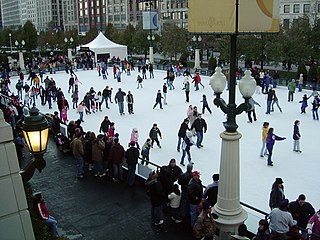
McCormick Tribune Plaza & Ice Rink or McCormick Tribune Plaza is a multi-purpose venue within Millennium Park in the Loop community area of Chicago, Illinois, in the United States. On December 20, 2001, it became the first attraction in Millennium Park to open. The $3.2 million plaza was funded by a donation from the McCormick Tribune Foundation. It has served as an ice skating rink, a dining facility and briefly as an open-air exhibition space.

Grainger Plaza is a public space that hosts the Cloud Gate sculpture. It is located in Millennium Park, which is a park built to celebrate the third millennium and which is located within the Loop community area of Chicago, Illinois in the United States. The sculpture and the plaza are sometimes jointly referred to as Cloud Gate on the AT&T Plaza.

The Exelon Pavilions are four buildings that generate electricity from solar energy and provide access to underground parking in Millennium Park in the Loop community area of Chicago in Cook County, Illinois, United States. The Northeast Exelon Pavilion and Northwest Exelon Pavilion are located on the northern edge of the park along Randolph Street, and flank the Harris Theater. The Southeast Exelon Pavilion and Southwest Exelon Pavilion are located on the southern edge of the park along Monroe Street, and flank the Lurie Garden. Together the pavilions generate 19,840 kilowatt-hours (71,400 MJ) of electricity annually, worth about $2,350 per year.
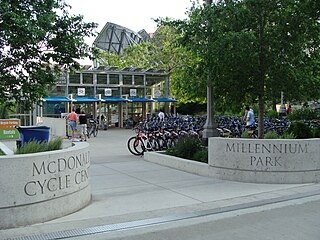
McDonald's Cycle Center is a facility for a Chicago Police Department Bike Patrol Group in the northeast corner of Millennium Park in the Loop community area of Chicago, in the U.S. state of Illinois. It was formerly a bicycle station for public use. The city of Chicago built the center at the intersection of East Randolph Street and Columbus Drive, and opened it July 2004. Since June 2006, it had been sponsored by McDonald's and several other partners, including city departments and bicycle advocacy organizations. The bike station, which formerly served bicycle commuters and utility cyclists, provided lockers, showers, a snack bar with outdoor summer seating, bike repair, bike rental and 300 bicycle parking spaces as of 2004. The Cycle Center was accessible by membership and day pass. It also accommodated runners and inline skaters, but now is exclusively used by a Chicago Police Department Bike Patrol Group.

Boeing Galleries are a pair of outdoor exhibition spaces within Millennium Park in the Loop community area of Chicago in Cook County, Illinois, United States. The spaces are located along the south and north mid-level terraces, above and east of Wrigley Square and the Crown Fountain. In a conference at the Chicago Cultural Center, Boeing President and Chief Executive Officer James Bell to Chicago Mayor Richard M. Daley announced Boeing would make a $5 million grant to fund both the construction of and an endowment for the space.

Chase Promenade is an open-air, tree-lined, pedestrian walkway that opened July 16, 2004. It is part of Millennium Park, which is located in the Loop community area of Chicago, Illinois in the United States. The promenade was made possible by a gift from the Bank One Foundation. It is 8 acres (3.2 ha) and used for exhibitions, festivals and other family events as well as private rentals.
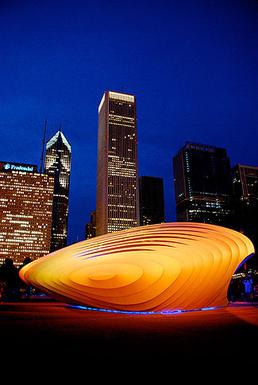
The Burnham Pavilions were public sculptures by Zaha Hadid and Ben van Berkel in Millennium Park, which were located in the Loop community area of Chicago, Illinois. Both pavilions were located in the Chase Promenade South. Their purpose was to commemorate the 100th anniversary of Daniel Burnham's Plan of Chicago, and symbolize the city's continued pursuit of the Plan's architectural vision with contemporary architecture and planning. The sculptures were privately funded and reside in Millennium Park. The pavilions were designed to be temporary structures.

The Petrillo Music Shell is an outdoor amphitheater in Grant Park in the Loop community area of Chicago in Cook County, Illinois, United States. It serves as host to many large annual music festivals in the city such as Chicago Blues Festival, Chicago Jazz Festival, Taste of Chicago and Lollapalooza.
Srinivasa "Hal" Iyengar was an Indian American civil engineer and a senior structural consultant, who has been particularly instrumental in the development of innovative and efficient structural concepts and systems for high-rise, long-span and stadium structures.



